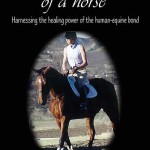
By Claire Dorotik, LMFT
“The outside of a horse is good for the inside of a man.”
If this statement is really true, there should be many uses for equine psychotherapy. However, being that the field of equine psychotherapy is relatively new, do we know if this is an appropriate method of treatment for trauma clients?
Sure, there have been many alternative forms of treating trauma clients — EMDR, biofeedback, meditation, even yoga — to describe just a few. What these forms of treatment share is the task of engaging the client’s awareness of both emotional and sensory responses to traumatic events.
In doing so, these methods attempt to identify the client’s emotional personality (EP), or the part of the personality that develops in response to being emotionally overwhelmed, and provide a means through which the client can integrate the EP with the apparently normal personality (ANP), or the part of the personality that develops in order to function on a daily basis.
While the ANP is present most frequently and useful for tasks such as holding down a job, engaging in a relationship and otherwise functioning, it does not allow for sensory experience. Under these circumstances, the client’s past memory will be semantic and his responses noetic, without emotional response.
When the client encounters threatening situations, or situations that appear threatening, such as stimuli for a previously traumatic experience, the EP will be activated and the memory episodic, and responses autonoetic, with feeling.
With the EP predominating, the client will not be able to modulate emotional responses cognitively and may become overwhelmed, and unable to function socially. Therefore, much of the work with trauma clients has been in facilitating the awareness of the EP, and providing a means for the person to mitigate these intense emotions and integrate them into the ANP, thereby reducing dissociation. As each one of these alternative methods uses a different modality to accomplish this, what is it that equine therapy offers?
To answer this question, it is first necessary to describe the use of the horse as a modality for treatment. Unlike other forms of therapy employed for trauma, the horse is a living being, with unique and immediate responses. And in partnering with the horse in trauma work, we must be conscious of the level at which the horse communicates, which is determined largely through the evolutionary demands of survival.
Being a prey animal, existing, for the horse, is dependent directly on perception of danger, and reaction, in the form of flight response. In working with horses, then, we must understand that this survival response always takes precedence, and will override any other input. This of course, makes the horse a very sensitive, perceptive animal, primed to sense threat a mile away.
To a horse, what represents the most threat is not emotion that is expressed, it is emotion that is covert, or, in the case of a trauma client, housed in the EP. As herd safety is predicated on maintaining continuity among members, and communication happens largely on a physiological level, the horse receives and responds to the signals sent from the EP much more than from the ANP. And when the EP is not expressed, this halts the very communication on which the horse depends.
In this case, the horse will do what a herd animal does – he will work to restore communication. What this means is that he will attempt to engage the EP. For example, he may provoke a client who has repressed anger. Should the client express the anger, it will not only make him readable to the horse — the physiological responses now in accordance with behavior — and thereby able to function as a herd member, but it will dislodge the anger from the EP. And when the horse’s behavior is accurately interpreted by a savvy therapist — in the context of a herd animal — it provides valuable insight into the complicated world of a trauma client.
Claire Dorotik, M.A. is a licensed marriage and family therapist specializing in trauma, weight loss, eating disorders, addictions, and dual diagnosis. Claire utilizes equine facilitated psychotherapy from a psychoanalytic perspective to offer clients a unique method to understand themselves. Claire has written extensively on the topics of the psychology of weight loss, food and substance addictions, trauma, and equine therapy. Her first three books, ON THE BACK OF A HORSE: Harnessing the healing Power of the Human-Equine Bond, NO SECRET SO CLOSE: A True Story of a Father’s Murder, A Mother’s Betrayal, A Family Torn Apart, and The Horses That Turned It All Around, and ALL KIDS ARE BORN THIN: A Parent’s Guide To Understanding and Preventing Childhood Obesity, are now available on Amazon Kindle. Further information on Claire, or her upcoming books, can be found at www.clairedorotik.com.
2 thoughts on “Can Equine Therapy Be Useful for Trauma Clients?”